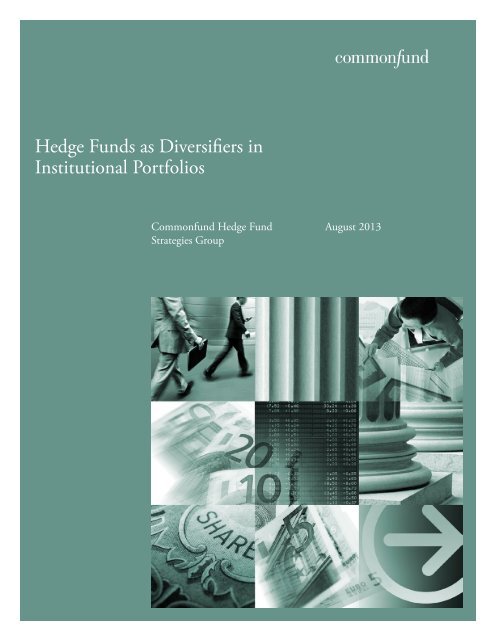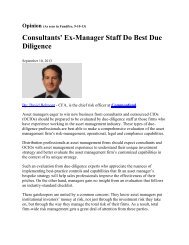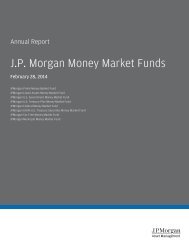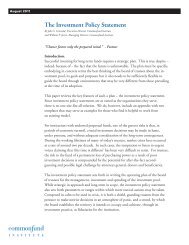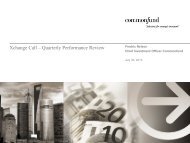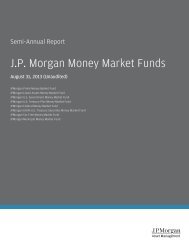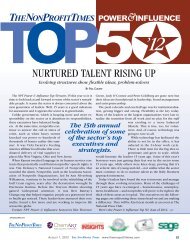Hedge Funds as Diversifiers in Institutional Portfolios - Commonfund
Hedge Funds as Diversifiers in Institutional Portfolios - Commonfund
Hedge Funds as Diversifiers in Institutional Portfolios - Commonfund
Create successful ePaper yourself
Turn your PDF publications into a flip-book with our unique Google optimized e-Paper software.
<strong>Hedge</strong> <strong>Funds</strong> <strong>as</strong> <strong>Diversifiers</strong> <strong>in</strong> <strong>Institutional</strong> <strong>Portfolios</strong> August 2013<br />
1<br />
<strong>Hedge</strong> <strong>Funds</strong> <strong>as</strong> <strong>Diversifiers</strong> <strong>in</strong><br />
<strong>Institutional</strong> <strong>Portfolios</strong><br />
<strong>Commonfund</strong> <strong>Hedge</strong> Fund<br />
Strategies Group<br />
August 2013
<strong>Hedge</strong> <strong>Funds</strong> <strong>as</strong> <strong>Diversifiers</strong> <strong>in</strong> <strong>Institutional</strong> <strong>Portfolios</strong> August 2013<br />
Table of Contents<br />
Contents<br />
Executive Summary.......................................................... 1<br />
Introduction..................................................................... 2<br />
Correlation and the Growth of the<br />
<strong>Hedge</strong> Fund Industry....................................................... 3<br />
Alpha Generation............................................................. 4<br />
Diversity of Beta Exposure............................................... 5<br />
Authors<br />
Kristofer Kwait<br />
Manag<strong>in</strong>g Director<br />
kkwait@cfund.org<br />
John Delano<br />
Director<br />
jdelano@cfund.org<br />
Just<strong>in</strong> Santana, CAIA<br />
Director<br />
jsantana@cfund.org<br />
<strong>Commonfund</strong> <strong>Hedge</strong> Fund Strategies Group<br />
15 Old Danbury Road<br />
Wilton, CT 06897<br />
203.563.5000<br />
About <strong>Commonfund</strong><br />
<strong>Hedge</strong> Fund Strategies Group<br />
<strong>Commonfund</strong> <strong>Hedge</strong> Fund Strategies Group is a division of<br />
<strong>Commonfund</strong> Asset Management Company, Inc., a wholly<br />
owned subsidiary of <strong>Commonfund</strong>. S<strong>in</strong>ce our <strong>in</strong>itial hedge<br />
fund <strong>in</strong>vestment <strong>in</strong> 1982, <strong>Commonfund</strong> h<strong>as</strong> played a fiduciary<br />
role <strong>in</strong> select<strong>in</strong>g hedge fund <strong>in</strong>vestments for our clients. We<br />
employ an <strong>in</strong>stitutional <strong>in</strong>vestment management philosophy<br />
and process <strong>in</strong> a fiduciary framework to help clients with<br />
hedge fund allocations through the creation of <strong>in</strong>novative<br />
multi-manager funds and customized separate accounts.
<strong>Hedge</strong> <strong>Funds</strong> <strong>as</strong> <strong>Diversifiers</strong> <strong>in</strong> <strong>Institutional</strong> <strong>Portfolios</strong> August 2013 1<br />
Executive Summary<br />
In the not too distant p<strong>as</strong>t, hedge funds were often considered<br />
mysterious, exotic, and elusive <strong>in</strong>vestment vehicles that<br />
revealed little about their methods of generat<strong>in</strong>g return.<br />
As the <strong>in</strong>dustry h<strong>as</strong> matured and standards of transparency<br />
have evolved, that perception seems to have mostly faded.<br />
Meanwhile, other broad tags of disapproval, such <strong>as</strong> that<br />
hedge funds are expensive, glorified <strong>in</strong>dexers - <strong>in</strong> essence,<br />
the opposite of exotic and mysterious – have more recently<br />
taken their place. While these extremes reflect some degree of<br />
hyperbole, they also reflect legitimate concerns and important<br />
considerations for hedge fund <strong>in</strong>vestors: avoid <strong>in</strong>vestments<br />
that are <strong>in</strong>accessible and not able to be understood; avoid<br />
construct<strong>in</strong>g a hedge fund allocation that is redundant and<br />
<strong>in</strong>efficient <strong>in</strong> a portfolio. But for most, the reality of hedge<br />
fund <strong>in</strong>vest<strong>in</strong>g is very much <strong>in</strong>-between: the <strong>in</strong>accessibility and<br />
mysteriousness of hedge funds is often overstated, and their<br />
value <strong>as</strong> diversifiers is often understated.<br />
<strong>Hedge</strong> funds cont<strong>in</strong>ue to present a compell<strong>in</strong>g value<br />
proposition to <strong>in</strong>stitutional <strong>in</strong>vestors <strong>as</strong> volatility dampeners,<br />
absolute return vehicles <strong>in</strong> certa<strong>in</strong> c<strong>as</strong>es, and <strong>as</strong> less-correlated<br />
sources of return. As an <strong>in</strong>vestment cl<strong>as</strong>s they have historically<br />
demonstrated the ability to generate superior, risk-adjusted<br />
returns to the broad market. Even <strong>in</strong> periods when hedge<br />
funds underperform the broad market they still provide<br />
me<strong>as</strong>urable value to a portfolio. After all, if completely<br />
confident <strong>in</strong> the direction of the market, an <strong>in</strong>vestor would not<br />
need hedge funds or any other source of diversification.<br />
• The growth of the <strong>in</strong>dustry h<strong>as</strong> led to an<br />
<strong>in</strong>cre<strong>as</strong>ed number of correlated managers,<br />
but it h<strong>as</strong> also led to an <strong>in</strong>cre<strong>as</strong>ed number of<br />
uncorrelated managers. In fact, the s<strong>in</strong>gle largest<br />
area of growth over time h<strong>as</strong> been <strong>in</strong> the group<br />
of managers with the lowest percentage of their<br />
returns expla<strong>in</strong>ed by those of the broad equity<br />
market. For a thoughtful, strategic <strong>in</strong>vestor,<br />
this diversity provides the opportunity to atta<strong>in</strong><br />
portfolio diversification <strong>in</strong>dependent of market<br />
direction.<br />
• The long-term, alpha-b<strong>as</strong>ed c<strong>as</strong>e for hedge<br />
funds rema<strong>in</strong>s strong, despite recent decl<strong>in</strong>es <strong>in</strong><br />
alpha co<strong>in</strong>cid<strong>in</strong>g with unusually adverse market<br />
conditions for security selection generally.<br />
• In addition to significant alpha, hedge funds<br />
also offer a diverse array of systematic or market<br />
exposures.<br />
• <strong>Hedge</strong> funds are not a monolithic entity, nor<br />
should they be considered a s<strong>in</strong>gle and uniform<br />
<strong>in</strong>vestment cl<strong>as</strong>s. They are highly diverse both<br />
among and with<strong>in</strong> strategies.
<strong>Hedge</strong> <strong>Funds</strong> <strong>as</strong> <strong>Diversifiers</strong> <strong>in</strong> <strong>Institutional</strong> <strong>Portfolios</strong> August 2013<br />
2<br />
<strong>Hedge</strong> <strong>Funds</strong> <strong>as</strong> <strong>Diversifiers</strong> <strong>in</strong> <strong>Institutional</strong> <strong>Portfolios</strong><br />
Introduction<br />
Investors allocate to hedge funds for a wide array of re<strong>as</strong>ons.<br />
Some seek equity or fixed <strong>in</strong>come complements or substitutes,<br />
others pursue volatility dampeners and sources of less-correlated<br />
return, while others view hedge funds <strong>as</strong> a means of access<br />
to less-liquid or more complex securities. All of these re<strong>as</strong>ons<br />
can <strong>in</strong> some form be captured with<strong>in</strong> a s<strong>in</strong>gle category – risk.<br />
And for many, equities represent the dom<strong>in</strong>ant risk <strong>in</strong> their<br />
portfolios. Accord<strong>in</strong>g to the 2012 NACUBO-<strong>Commonfund</strong><br />
Study of Endowments (NCSE), the average U.S. endowment<br />
h<strong>as</strong> 46 percent of its <strong>as</strong>sets <strong>in</strong>vested <strong>in</strong> equities, and significantly<br />
more on a risk-weighted b<strong>as</strong>is. One of the primary<br />
roles of hedge funds for the typical <strong>in</strong>stitution, then, is often<br />
to provide a source of return that is only modestly correlated<br />
with the broad equity market.<br />
With<strong>in</strong> the public sphere, however, <strong>as</strong>sessments of hedge<br />
fund performance tend not to be <strong>as</strong> nuanced. Commentary<br />
like “…the S&P 500 w<strong>as</strong> up 16 percent <strong>in</strong> 2012, but hedge<br />
funds, private <strong>in</strong>vestment vehicles run by what many consider<br />
to be top managers, were up only 8 percent on average…” is<br />
often characteristic of f<strong>in</strong>ancial news commentary. While the<br />
particular flavor of media attention to hedge funds partially<br />
reflects backl<strong>as</strong>h aga<strong>in</strong>st a perceived element of exclusivity, it<br />
is important to note that these characterizations come with<br />
embedded <strong>as</strong>sumptions that may be <strong>in</strong>consistent with many<br />
<strong>in</strong>vestors’ goals.<br />
One implicit <strong>as</strong>sumption, for <strong>in</strong>stance, is that the success of a<br />
hedge fund – any hedge fund – should be viewed <strong>as</strong> a stand<strong>in</strong>g<br />
bet on the direction of the S&P 500 Index. This would<br />
presume that a hedge fund manager attempts to have long<br />
exposure to the equity market when it is go<strong>in</strong>g up and short<br />
when it is go<strong>in</strong>g down. Another is that hedge fund managers<br />
ought to be perpetually ahead of the most widely-followed,<br />
p<strong>as</strong>sive equity market <strong>in</strong>dex given their elite and talented<br />
status. In both c<strong>as</strong>es, the hedge fund universe is understood<br />
narrowly <strong>in</strong> terms of two monolithic entities: “<strong>Hedge</strong> <strong>Funds</strong>,”<br />
capital H, capital F, and “The Market,” capital M.<br />
Actual (<strong>as</strong> opposed to theoretical) hedge fund <strong>in</strong>vest<strong>in</strong>g,<br />
however, requires thoughtful, careful decision-mak<strong>in</strong>g with<br />
significantly more context around strategies and their risk and<br />
return properties.
<strong>Hedge</strong> <strong>Funds</strong> <strong>as</strong> <strong>Diversifiers</strong> <strong>in</strong> <strong>Institutional</strong> <strong>Portfolios</strong> August 2013<br />
3<br />
Correlation and the Growth of the<br />
<strong>Hedge</strong> Fund Industry<br />
One charge often directed at hedge funds is that they offer<br />
little more than repackaged equity market risk even <strong>as</strong> skeptics<br />
acknowledge that hedge funds have historically delivered<br />
robust, uncorrelated returns with<strong>in</strong> certa<strong>in</strong> markets. However,<br />
many also <strong>as</strong>sert that the growth of the hedge fund <strong>in</strong>dustry<br />
h<strong>as</strong> built up <strong>in</strong>dustry-wide correlation on a large scale, with<br />
alpha <strong>in</strong>cre<strong>as</strong><strong>in</strong>gly scarce and fleet<strong>in</strong>g, and with <strong>in</strong>evitably<br />
overlapp<strong>in</strong>g trades erod<strong>in</strong>g diversification benefit. At a glance,<br />
the uptrend of broad hedge fund <strong>in</strong>dex correlation with the<br />
S&P 500 Index (here, the HFRI Fund weighted Composite<br />
Index) would seem to support these claims.<br />
As the hedge fund universe h<strong>as</strong> grown, competition for capital<br />
and the hunt for sources of return among <strong>in</strong>dividual managers<br />
have created an opportunity for more diversification, not<br />
less; <strong>in</strong> fact, a look with<strong>in</strong> the broad hedge fund universe<br />
contradicts the notion that hedge funds are solely driven by<br />
the equity markets. For <strong>in</strong>stance, a universe-wide look at<br />
correlations re<strong>as</strong>serts that the risk and return properties of a<br />
hedge fund allocation are not simply a function of the broad<br />
equity market. Below are roll<strong>in</strong>g 12-month R-Squared (a<br />
me<strong>as</strong>ure of the total share of return expla<strong>in</strong>ed by the S&P 500<br />
Index) of constituents of the HFRI Fund weighted Composite<br />
Index, represent<strong>in</strong>g all four major strategy groups – Equity<br />
<strong>Hedge</strong>, Event-Driven, Macro, and Relative Value – to the S&P<br />
500 Index.<br />
Aggregate <strong>Hedge</strong> Fund Relationship to U.S. Equity Market<br />
Roll<strong>in</strong>g 12-month R-sq., HFRI Fund Weighted Composite to S&P 500 Index<br />
Janaury 1993- April 2013<br />
100%<br />
90%<br />
80%<br />
70%<br />
60%<br />
50%<br />
40%<br />
30%<br />
20%<br />
10%<br />
0%<br />
Jan 93 Jan 96 Jan 99 Jan 02 Jan 05 Jan 08 Jan 11<br />
Source: HFRI and <strong>Commonfund</strong> <strong>Hedge</strong> Fund Strategies Group<br />
The hedge fund universe h<strong>as</strong> <strong>in</strong>deed grown by several-fold<br />
s<strong>in</strong>ce the “mystique” days of the early 1990s. Quantitative<br />
evidence suggests that many funds are largely vehicles for<br />
a form of broad market exposure (beta), and on an average<br />
b<strong>as</strong>is the typical hedge fund universe constituent seems to<br />
have become <strong>in</strong>cre<strong>as</strong><strong>in</strong>gly correlated with the equity market<br />
over time. However, for the prudent hedge fund <strong>in</strong>vestor, the<br />
correlation properties of the average hedge fund – represented<br />
by the HFRI Index – are not necessarily relevant to a<br />
thoughtful, thorough selection process.<br />
Number of Report<strong>in</strong>g Managers <strong>in</strong> the<br />
HFRI Fund Weighted Composite Universe<br />
Managers by Strategy | January 1992 - February 2013<br />
3000<br />
2500<br />
2000<br />
1500<br />
1000<br />
500<br />
Macro<br />
Relative Value<br />
0<br />
Event-Driven<br />
Jan 92 Jan 95 Jan 98 Jan 01 Jan 04 Jan 07 Jan 10 Jan 13<br />
Source: HFRI and <strong>Commonfund</strong> <strong>Hedge</strong> Fund Strategies Group<br />
Total<br />
Equity <strong>Hedge</strong><br />
With<strong>in</strong> the HFRI Fund weighted Composite <strong>in</strong>dex, <strong>as</strong> the<br />
total number of funds h<strong>as</strong> risen, the number of funds highly<br />
correlated with broad equity market h<strong>as</strong> also risen – but<br />
so, too, h<strong>as</strong> the number of uncorrelated funds. In fact,<br />
partition<strong>in</strong>g the manager universe on a 12-month roll<strong>in</strong>g b<strong>as</strong>is<br />
<strong>in</strong> terms of R-Squared to the equity market <strong>in</strong> 10 percent<br />
<strong>in</strong>crements, from December 1992 to December 2012, there<br />
w<strong>as</strong> a greater <strong>in</strong>cre<strong>as</strong>e <strong>in</strong> the number of managers with less<br />
than 10 percent of return expla<strong>in</strong>ed by the S&P 500 Index<br />
than any other group.
<strong>Hedge</strong> <strong>Funds</strong> <strong>as</strong> <strong>Diversifiers</strong> <strong>in</strong> <strong>Institutional</strong> <strong>Portfolios</strong> August 2013<br />
4<br />
More Correlated Managers...and More Uncorrelated Managers<br />
Number of<br />
Managers<br />
1000<br />
800<br />
600<br />
400<br />
200<br />
0<br />
Dec-92<br />
Dec-97<br />
Dec-02<br />
Dates<br />
Dec-07<br />
Dec-12<br />
<strong>Hedge</strong> <strong>Funds</strong> <strong>as</strong> <strong>Diversifiers</strong> <strong>in</strong> <strong>Institutional</strong> <strong>Portfolios</strong> August 2013<br />
5<br />
An additional step is to substitute an <strong>in</strong>dex represent<strong>in</strong>g<br />
“hedge fund beta” itself for the S&P 500 Index. The Goldman<br />
Sachs Absolute Return Tracker ETF (GJRTX) is one of the<br />
most recognized hedge fund replicators, and the chart below<br />
demonstrates that on a s<strong>in</strong>gle-factor b<strong>as</strong>is the large majority<br />
(approximately 84 percent) of the report<strong>in</strong>g hedge fund<br />
universe h<strong>as</strong> produced positive alpha on a relative b<strong>as</strong>is.<br />
HFRI Fund weighted Universe<br />
Beta(x), Alpha (y) to Goldman Sachs Absolute Return Tracker<br />
June 2008 - February 2013<br />
8.00%<br />
6.00%<br />
4.00%<br />
2.00%<br />
-2.00%<br />
-4.00%<br />
84% Positive Alpha<br />
0.00%<br />
-6 -4 -2 0 2 4 6 8 10 12<br />
Source: HFRI, Goldman Sachs, Bloomberg and <strong>Commonfund</strong> <strong>Hedge</strong> Fund<br />
Strategies Group<br />
Does the result suggest that the overwhelm<strong>in</strong>g majority of<br />
hedge funds produces positive alpha, after account<strong>in</strong>g for<br />
market risk, to the rest of the hedge fund universe? That<br />
certa<strong>in</strong>ly seems unlikely. The strength of this result must<br />
be at le<strong>as</strong>t partially attributable to familiar datab<strong>as</strong>e bi<strong>as</strong>es,<br />
like survivorship among report<strong>in</strong>g members, along with the<br />
replicator itself - designed to produce hedge fund beta and not<br />
alpha. The result does, however, strongly suggest that stat<strong>in</strong>g<br />
that the universes of <strong>in</strong>vestable hedge funds are either<br />
1) simply <strong>in</strong>terchangeable, or 2) simply vehicles for market risk<br />
is greatly overstated.<br />
Diversity of Beta Exposure<br />
In addition to uncorrelated returns and alpha, the hedge<br />
fund value for <strong>in</strong>stitutional <strong>in</strong>vestors is diverse market (beta)<br />
exposure. Across the hedge fund universe, specific strategies<br />
and are<strong>as</strong> of specialization draw managers <strong>in</strong>to different<br />
markets us<strong>in</strong>g different methods. This results <strong>in</strong> significant<br />
diversity <strong>in</strong> the statistical properties of historical returns.<br />
To illustrate this concept, below are two sets of multi-factor<br />
“beta” profiles for <strong>in</strong>dividual managers report<strong>in</strong>g to the HFRI<br />
datab<strong>as</strong>e. The first chart shows results for Equity <strong>Hedge</strong><br />
managers vs. common equity factors, the second for Relative<br />
Value and Event-Driven managers vs. credit-related factors.<br />
In both c<strong>as</strong>es, the horizontal (x-) axis shows the “beta” or<br />
systematic exposure to one factor and the vertical (y-) axis<br />
shows simultaneous exposure to another.<br />
HFRI Equity <strong>Hedge</strong> Universe<br />
Beta to Regional Broad Market(x), Regional Value (HML) (y)<br />
Factors<br />
Three years end<strong>in</strong>g December 2012<br />
US<br />
Asia<br />
Europe<br />
0.0<br />
-2.0 -1.5 -1.0 -0.5 0.0 0.5 1.0 1.5 2.0<br />
Source: HFRI, PerTrac and <strong>Commonfund</strong> <strong>Hedge</strong> Fund Strategies Group<br />
HFRI Relative Value and Event-Driven Universe<br />
Beta to Parallel Shift Down(x), Flatten<strong>in</strong>g (y) <strong>in</strong> Credit Spreads<br />
(Pr<strong>in</strong>cipal Component Factors)<br />
Three years end<strong>in</strong>g December 2012<br />
6.00%<br />
4.0<br />
3.0<br />
2.0<br />
1.0<br />
-1.0<br />
-2.0<br />
-3.0<br />
4.00%<br />
2.00%<br />
0.00%<br />
-1.50% -1.00% -0.50% 0.00% 0.50% 1.00% 1.50% 2.00% 2.50%<br />
-2.00%<br />
-4.00%<br />
Source: HFRI, BoAML and <strong>Commonfund</strong> <strong>Hedge</strong> Fund Strategies Group
<strong>Hedge</strong> <strong>Funds</strong> <strong>as</strong> <strong>Diversifiers</strong> <strong>in</strong> <strong>Institutional</strong> <strong>Portfolios</strong> August 2013<br />
6<br />
In the equity hedge example, the first factor is sensitivity to<br />
a regional broad market (S&P 500, MSCI Europe, MSCI<br />
Asia ex-Japan) applied to managers b<strong>as</strong>ed on their region of<br />
focus. In addition to broad market exposure, managers exhibit<br />
different bi<strong>as</strong>es to fundamental equity valuation factors.<br />
Exposure to such bi<strong>as</strong>es <strong>in</strong> stock selection is often considered<br />
a form of systematic risk; <strong>in</strong> the c<strong>as</strong>e of value it makes sense to<br />
consider this a “beta” to a regional value factor. In this c<strong>as</strong>e,<br />
the regional value factors are b<strong>as</strong>ed on academic researcher<br />
Kenneth French’s Fama/French benchmark factor HML 2 .<br />
Particularly notable here is the dispersion of the systematic<br />
risk exposures. If managers were <strong>in</strong> fact best considered a<br />
monolithic undifferentiated m<strong>as</strong>s, the plot po<strong>in</strong>ts would<br />
be tightly concentrated <strong>in</strong> a s<strong>in</strong>gle area. Instead, they are<br />
scattered across the surface of the chart.<br />
The second chart makes a similar c<strong>as</strong>e with<strong>in</strong> the Relative<br />
Value and Event-Driven universes, show<strong>in</strong>g sensitivity to<br />
two forms of systematic risk exposure with<strong>in</strong> corporate<br />
credit-spreads:<br />
1. a parallel shift down <strong>in</strong> spreads across the entire credit<br />
rat<strong>in</strong>gs spectrum (i.e., credit spreads are tighten<strong>in</strong>g to a<br />
similar degree <strong>in</strong> all rat<strong>in</strong>gs categories) and,<br />
2. a “flatten<strong>in</strong>g” <strong>in</strong> spreads (i.e., the spreads of lower-rated<br />
credits are tighten<strong>in</strong>g more relative to higher-rated<br />
credits, suggest<strong>in</strong>g outperformance of riskier credits).<br />
Managers to the right of the vertical axis have a statistical bi<strong>as</strong><br />
towards a broad credit rally, and managers above the horizontal<br />
axis towards outperformance <strong>in</strong> lower-quality credits (plot<br />
po<strong>in</strong>ts <strong>in</strong> the upper right quadrant suggest positive sensitivity<br />
to both factors). While the majority of constituents <strong>in</strong> the<br />
two strategy universes are generally neutral-to-long credit (<strong>as</strong><br />
opposed to short), and are largely expected to perform better<br />
<strong>in</strong> environments characterized by outperformance of lowerrated<br />
credits, the broad scatter<strong>in</strong>g of plot po<strong>in</strong>ts also suggests<br />
significant dispersion <strong>in</strong> the beta risk profiles of the managers.<br />
This diversity of exposure is another critical <strong>as</strong>pect of the<br />
diversification benefit that hedge funds can offer <strong>in</strong>stitutional<br />
portfolios: hedge funds are diverse and come <strong>in</strong> many forms<br />
with respect to their systematic risks.<br />
2<br />
SMB and HML, or the Fama/French factors, are constructed b<strong>as</strong>ed on<br />
size- and book-to-market. HML (High M<strong>in</strong>us Low) is the average return on<br />
two value portfolios m<strong>in</strong>us the average return on two growth portfolios. SMB<br />
(Small M<strong>in</strong>us Big) is the average return on three small portfolios m<strong>in</strong>us the<br />
average return on three big portfolios. For more detail, see http://mba.tuck.<br />
dartmouth.edu/pages/faculty/ken.french/data_library.html, and see Fama and<br />
French, 1993, “Common Risk Factors <strong>in</strong> the Returns on Stocks and Bonds,”<br />
Journal of F<strong>in</strong>ancial Economics, for a complete description of the factor<br />
returns.<br />
Endnote to HFRI Relative Value and Event-Driven Universe multifactor<br />
“beta” profile:<br />
Credit beta factors used <strong>in</strong> scatter chart are b<strong>as</strong>ed on pr<strong>in</strong>cipal<br />
components of correlation matrix of 10 option-adjusted corporate<br />
credit spreads, with Bank of America Merrill Lynch credit spread<br />
<strong>in</strong>dices used <strong>as</strong> <strong>in</strong>puts. Load<strong>in</strong>gs are represented below.<br />
• Parallel shift: spreads narrow across the rat<strong>in</strong>gs/quality<br />
spectrum<br />
• Flatten<strong>in</strong>g: spreads on lower-rated credits narrow more<br />
than those of higher-rated, potentially with widen<strong>in</strong>g<br />
among higher-rated. Scenario may be <strong>in</strong>terpreted to<br />
represent a migration to higher-risk, higher-yield<strong>in</strong>g credit<br />
that is uncorrelated with the parallel shift factor.<br />
Two forms of shifts <strong>in</strong> credit spreads represented by<br />
Pr<strong>in</strong>cipal Components<br />
0.8<br />
0.6<br />
0.4<br />
0.2<br />
0<br />
-0.2<br />
-0.4<br />
Flatten<strong>in</strong>g/Steepen<strong>in</strong>g<br />
Parallel Shift<br />
AAA AAA-AA AA A A-BBB BBB BB BB-B B CCC
<strong>Hedge</strong> <strong>Funds</strong> <strong>as</strong> <strong>Diversifiers</strong> <strong>in</strong> <strong>Institutional</strong> <strong>Portfolios</strong> August 2013<br />
7<br />
Market Commentary<br />
Information, op<strong>in</strong>ions, or commentary concern<strong>in</strong>g the f<strong>in</strong>ancial markets, economic conditions, or other topical subject matter are prepared,<br />
written, or created prior to post<strong>in</strong>g on this Report and do not reflect current, up-to-date, market or economic conditions. <strong>Commonfund</strong><br />
disclaims any responsibility to update such <strong>in</strong>formation, op<strong>in</strong>ions, or commentary.<br />
To the extent views presented forec<strong>as</strong>t market activity, they may be b<strong>as</strong>ed on many factors <strong>in</strong> addition to those explicitly stated <strong>in</strong> this<br />
Report. Forec<strong>as</strong>ts of experts <strong>in</strong>evitably differ. Views attributed to third parties are presented to demonstrate the existence of po<strong>in</strong>ts of view,<br />
not <strong>as</strong> a b<strong>as</strong>is for recommendations or <strong>as</strong> <strong>in</strong>vestment advice. Managers who may or may not subscribe to the views expressed <strong>in</strong> this Report<br />
make <strong>in</strong>vestment decisions for funds ma<strong>in</strong>ta<strong>in</strong>ed by <strong>Commonfund</strong> or its affiliates. The views presented <strong>in</strong> this Report may not be relied upon<br />
<strong>as</strong> an <strong>in</strong>dication of trad<strong>in</strong>g <strong>in</strong>tent on behalf of any <strong>Commonfund</strong> fund, or of any <strong>Commonfund</strong> managers.<br />
Market and <strong>in</strong>vestment views of third parties presented <strong>in</strong> this Report do not necessarily reflect the views of <strong>Commonfund</strong> and <strong>Commonfund</strong><br />
disclaims any responsibility to present its views on the subjects covered <strong>in</strong> statements by third parties.<br />
Statements concern<strong>in</strong>g <strong>Commonfund</strong> Group’s views of possible future outcomes <strong>in</strong> any <strong>in</strong>vestment <strong>as</strong>set cl<strong>as</strong>s or market, or of possible<br />
future economic developments, are not <strong>in</strong>tended, and should not be construed, <strong>as</strong> forec<strong>as</strong>ts or predictions of the future <strong>in</strong>vestment<br />
performance of any <strong>Commonfund</strong> Group fund. Such statements are also not <strong>in</strong>tended <strong>as</strong> recommendations by any <strong>Commonfund</strong> Group entity<br />
or employee to the recipient of the presentation. It is <strong>Commonfund</strong> Group’s policy that <strong>in</strong>vestment recommendations to <strong>in</strong>vestors must be<br />
b<strong>as</strong>ed on the <strong>in</strong>vestment objectives and risk tolerances of each <strong>in</strong>dividual <strong>in</strong>vestor. All market outlook and similar statements are b<strong>as</strong>ed upon<br />
<strong>in</strong>formation re<strong>as</strong>onably available <strong>as</strong> of the date of this presentation (unless an earlier date is stated with regard to particular <strong>in</strong>formation),<br />
and re<strong>as</strong>onably believed to be accurate by <strong>Commonfund</strong> Group. <strong>Commonfund</strong> Group disclaims any responsibility to provide the recipient of<br />
this presentation with updated or corrected <strong>in</strong>formation.


